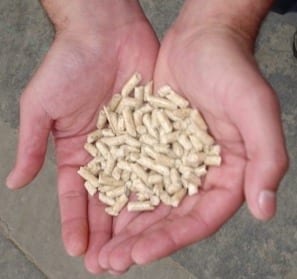
Converting from power plants from coal- to wood-fired may not deliver environmental benefits as advertised
In the midst of black spruce and jack pine stands in northwestern Ontario’s Crown forests, a global trend has come home to roost. Atikokan Generating Station ceased burning coal last year to prepare for its new fuel: locally sourced wood pellets.
Canada already sends wood pellets abroad for power generation, but it is now leveraging the resource on a large scale in its own backyard. Atikokan will be the largest commercial power plant in North America to convert from coal to biomass, a trend that has caught on worldwide, especially in Europe.
The retrofit is part of Ontario’s plan to be the first jurisdiction in North America to shut down its coal fleet. In Europe the drive to retrofit coal-fired power plants to biomass comes from the European Union Renewable Energy Directive, which calls for 20 percent of energy to come from renewables, including biomass, by 2020. Much of Europe’s wood pellets are being imported from private forests in the southeastern U.S. as well other parts of North America.
The move away from dirty coal to a renewable resource is seen as a win in terms of carbon emissions by some governments, but not everyone agrees. The definition of sustainably harvested wood pellets varies by power plant and country, and some environmentalists fear that the growing need for biomass will outstrip any benefits from sidelining coal. “If we’re going to have this global trade in wood energy,” says Brian Kittler, project director at the Pinchot Institute for Conservation, “we have to ask, how well do the European and U.S. systems match up?’”
Studies have found that burning wood over fossil fuels produces about 65 to 95 percent less greenhouse gas emissions. Those studies, however, do not take into account the change in forest carbon stocks, according to Thomas Buchholz, a senior scientist at Spatial Informatics Group who studies greenhouse gas emissions related to bioenergy systems. When researchers start adding in the change to the forest carbon stock, the picture changes, which worries environmentalists. Although trees can be replanted, whereas coal is a finite resource in the short term, there is debate as to how much carbon smaller trees take up compared with mature trees. Based on a study Buchholz did for the Southern Environmental Law Center, if Europe imports southeastern U.S. wood instead of burning coal, atmospheric greenhouse gases could up to a 300 percent in the first 50 years, although they would drop below fossil fuel levels eventually.
In the U.K. Drax Power Station is spending $1.1 billion to convert half of its 4,000-megawatt coal-fired facility to wood pellets, much of which will be imported from North America. Although Drax has drafted sustainability guidelines, environmentalists question whether the world’s largest biomass power station will be able to sustain itself on wood pellets made from just logging residue. The European Union has delayed its final decision on wood pellet sourcing criteria several times.
Go deeper with Bing News on:
Wood power
- Bates inspired by 'super talented' Wood
The Kiwi, who partnered fellow rookie Bates in last year’s Dunlop Series, was called up by Walkinshaw Andretti United to replace Nick Percat alongside Chaz Mostert. After a double DNF out of his ...
- Consumers Energy crews restoring power in southwest Michigan after tornadoes hit
Hundreds of customers have power restored after multiple tornadoes tore through southwest Michigan on Tuesday. Consumers Energy crews have been working around the ...
- 9 Cathie Wood Quotes Every 20-Year-Old Needs To Hear
Cathie Wood, an American investor and the founder/CEO of investment management firm ARK Invest, provides highly applicable and helpful business and finance advice to her audience. If you’re just ...
- Wood scores 11:03 in OT as Avalanche finish off 3-goal comeback to beat Stars 4-3 to open 2nd round
When Woody get’s going like that, he’s hard to stop. He’s fast and he’s powerful, and he just took it to the house.”Staying ahead of defenseman Miro Heiskanen, Wood got the puck around Jake Oettinger ...
- Tap into your Magnum Potential; Here’s Why Johnny Sins Stands By Inno Supps Nitro Wood Magnum
Why settle for average when you’ve got the chance to unleash your Magnum potential with Inno Supps Nitro Wood Magnum? Just ask Johnny Sins and thousands of men who trust Inno Supps to power up their ...
Go deeper with Google Headlines on:
Wood power
[google_news title=”” keyword=”wood power” num_posts=”5″ blurb_length=”0″ show_thumb=”left”]
Go deeper with Bing News on:
Wood pellets
- After Months of Testing, Traeger Ironwood Is the Best Grill I've Ever Reviewed
The beauty of a Traeger is they’re designed for pellet grill newbs and veterans alike ... with Traeger’s oft-repeated line that everything tastes better cooked over wood. I’m even a big fan of the ...
- The Best Smokers of 2024 to Slow-Cook Butts, Brisket, and Ribs
The best gas grills, portable grills, and charcoal grills are all about efficiency. But the best smokers and pellet grills eschew ease. Purists prefer to cook low and slow over indirect heat with ...
- The Best Pellet Grills of 2024 Are Your Most Versatile Backyard Cookers
Sure, the best gas grills provide push-button convenience, the best portable grills ensure camp meals are spectacular, and the best charcoal grills bring back childhood nostalgia. But the best pellet ...
- Wood Pellet Fuel Market Insights: Industry Analysis and Forecasts
Report Ocean published the latest research report on the Wood Pellet Fuel market. In order to comprehend a market holistically, a variety of factors must be evaluated, including demographics, business ...
- The Best Pellet Grills and Smokers for Backyard Barbecues
Whether you prefer smoked chicken or well-done steak, the best pellet grills and smokers deliver. Their versatility and ease of use set them apart from other types of grills. Wood pellets can ...
Go deeper with Google Headlines on:
Wood pellets
[google_news title=”” keyword=”wood pellets” num_posts=”5″ blurb_length=”0″ show_thumb=”left”]








